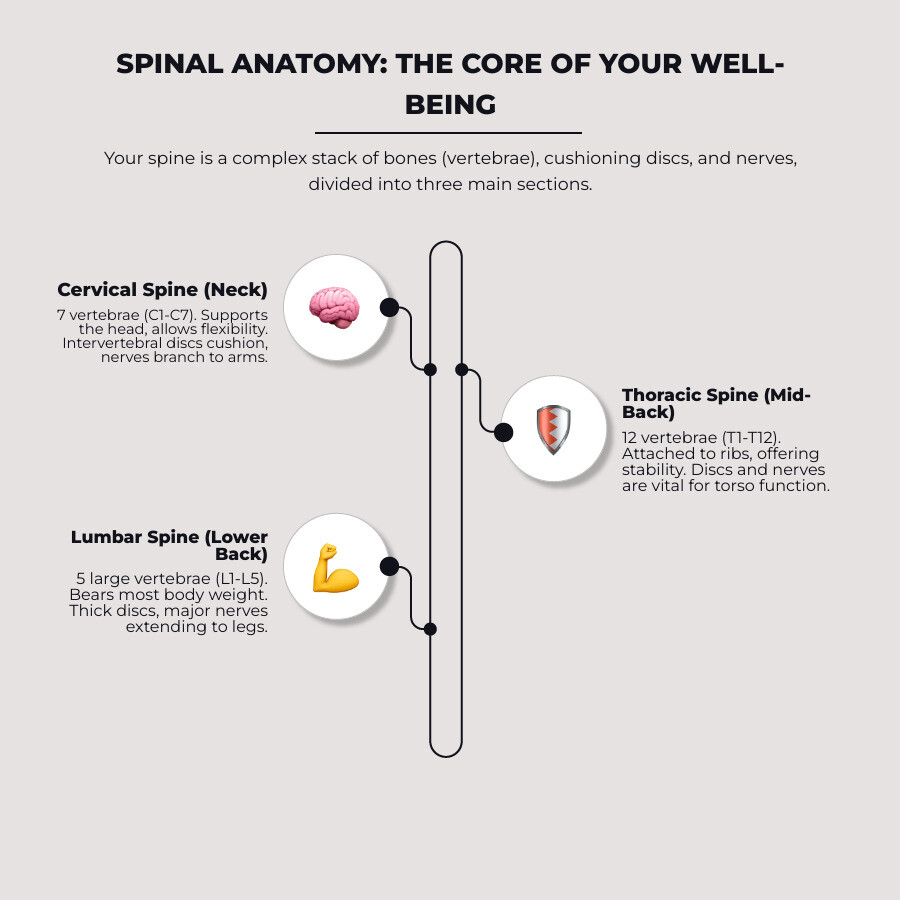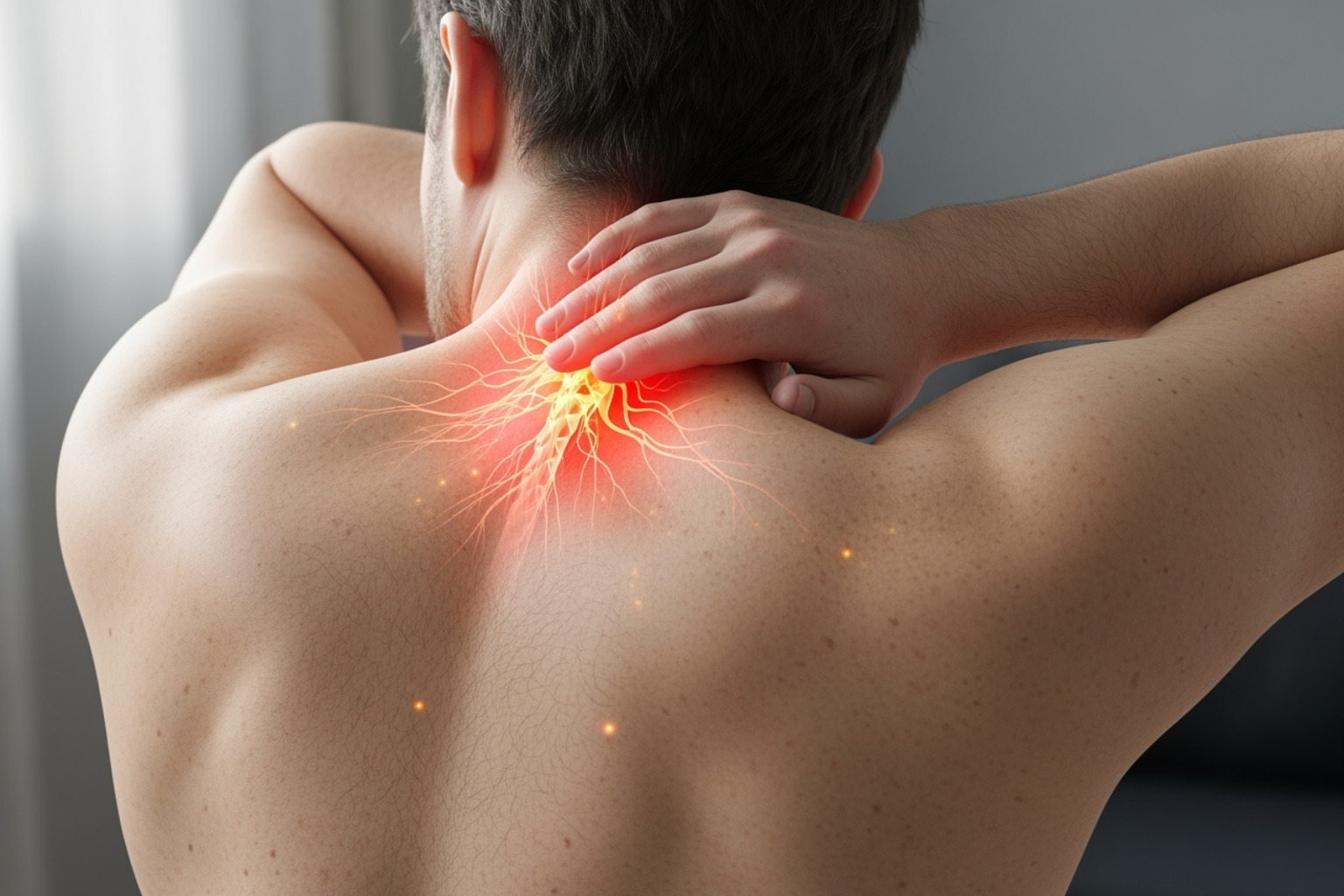Why Back and Neck Pain Affects Millions Every Day
Back and neck pain are among the most common health complaints, affecting eight out of ten people in their lifetime. From a sudden sharp pain to a persistent ache, understanding the cause is the first step toward finding relief.
Quick Overview: Back and Neck Pain Essentials
- Prevalence: Affects 10-20% of adults for neck pain; back pain impacts 8 out of 10 people
- Common Causes: Poor posture, muscle strain, disc problems, arthritis, stress
- Types: Acute (days to weeks) vs. chronic (3+ months)
- Symptoms: Aching, stiffness, shooting pain, numbness, limited movement
- Treatment: Rest, ice/heat therapy, topical pain relief, gentle exercise, professional care when needed
Your spine is a complex structure of vertebrae, discs, muscles, and ligaments. An injury to any part can significantly impact your daily activities and quality of life.
The good news is that most cases respond well to conservative treatments. This guide will help you understand your body, know when to seek help, and find effective ways to manage and prevent pain.
Modern lifestyle factors - from prolonged sitting to "tech neck" from looking down at phones - have made these conditions increasingly common. But with the right knowledge and tools, including targeted nerve pain relief cream and muscle pain relief cream options, you can take control of your spinal health.
I'm Tony Enrico, and through my work developing advanced pain relief solutions at Neuropasil, I've helped thousands of athletes and individuals find effective relief from back and neck pain using natural, fast-acting approaches. My experience has shown me that combining proper understanding with the right treatment methods leads to the best outcomes for lasting relief.

Understanding the Root Causes and Types of Spinal Pain
Your spine is a flexible tower of 33 bones (vertebrae) that keep you upright and mobile. Between each vertebra are intervertebral discs, which act as shock absorbers. A network of muscles and ligaments provides support and allows movement, while the spinal cord and nerves run through the center, carrying messages between your brain and body.
Back and neck pain often develops when this system is strained. Common culprits include muscle strain from awkward lifting, poor posture from desk work, sedentary lifestyles, and repetitive motions.
The NIH research on Low Back Pain shows just how common these issues have become. For a deeper understanding of what might be causing your specific discomfort, our guide on Lower Back Pain Causes offers detailed insights.
Acute vs. Chronic Pain
Not all back and neck pain is the same, and understanding the difference can help guide your approach to relief.
Acute pain is your body's alarm system, appearing suddenly after an injury or strain. It's typically short-lived, lasting from a few days to several weeks, and usually resolves with rest and proper care.
Chronic pain persists for three months or longer. It can be constant or intermittent and often has more complex causes, sometimes lingering even after an initial injury has healed.
Understanding whether you're dealing with acute or chronic pain helps determine the best path forward – acute issues often respond well to simple home care and muscle pain relief cream, while chronic conditions might need a more comprehensive management approach.
Common Conditions and Triggers
Several conditions beyond simple muscle strain can cause pain. With age, degenerative disc changes can occur, as spinal discs lose water content and become less effective cushions.
Bulging or herniated discs happen when a disc's inner material pushes out and presses on nerves, causing radiating pain. This is what occurs in conditions like Sciatica Pain, where a compressed lower back nerve causes pain down the leg.
Other common conditions include spinal stenosis (narrowing of the spinal canal), osteoarthritis (joint wear and tear), and myofascial pain (affecting muscle connective tissue). Injuries from accidents or sports can also cause both acute and chronic back and neck pain.
Modern habits are major contributors. Poor posture, "tech neck" from phone use, incorrect lifting, and prolonged sitting all strain the spine. Excess weight and smoking can also worsen back and neck pain and slow healing.
The encouraging news is that understanding these root causes puts you in a much better position to find effective relief, whether through targeted nerve pain relief cream applications, lifestyle modifications, or professional treatment approaches.
Recognizing the Symptoms and Red Flags
Back and neck pain manifests in various ways. Recognizing the symptoms can help you decide between self-care and seeking medical advice.

Common initial sensations include deep muscle aches and stiffness that limits your range of motion, making simple movements like turning your head or tying your shoes difficult.
Typical Symptoms of Back and Neck Pain
Pain can range from a dull ache to sharp, shooting pain that feels like an electric shock, often indicating nerve involvement. Other typical symptoms include:
- Headaches: Often starting at the base of the skull due to neck muscle tension.
- Numbness or Tingling: A "pins and needles" feeling in the arms or legs, signaling nerve pressure. Our guide on Sciatica Symptoms 101 explains this further for lower body symptoms.
- Muscle Spasms: Painful, involuntary muscle contractions that lock up the area.
- Pain Worsened by Movement: Certain positions or activities may trigger or increase pain.
When to Seek Immediate Medical Help
While most back and neck pain is manageable, some red flag symptoms require immediate medical attention as they can signal a more serious condition.
- Loss of bladder or bowel control: This indicates possible severe spinal cord compression and is a medical emergency.
- Fever or chills with pain: Could signal a spinal infection.
- Unexplained weight loss: May point to an underlying condition.
- Progressive weakness or numbness in limbs: Suggests significant nerve compression.
- Severe pain after an injury: A fall or accident requires evaluation for fractures or structural damage.
- Pain that doesn't improve with rest: Most mechanical pain eases with rest; if yours doesn't, see a doctor.
The good news is that the vast majority of back and neck pain episodes don't involve these serious red flags. Most people find relief through a combination of rest, gentle movement, and targeted treatments like nerve pain relief cream for tingling sensations or muscle pain relief cream for those persistent aches and spasms.
Professional Diagnosis and Treatment Pathways
If your back and neck pain persists for weeks, worsens, or includes red flag symptoms, it's time to see a healthcare professional to diagnose the underlying cause.
The diagnostic process usually starts with a physical examination to check your movement, posture, and reflexes, along with a review of your medical history. If needed, your doctor may order diagnostic tests like X-rays for bone issues or an MRI scan for detailed images of soft tissues like discs and nerves. Other tests like CT scans or electromyography (EMG) can provide more specific information on bone or nerve damage.
For those dealing with nerve-related symptoms, understanding how targeted solutions work alongside medical care can be incredibly valuable. Our guide on Nerve Pain Relief with Neuropasil explains how natural ingredients can complement your treatment plan.
Non-Surgical Medical Approaches
Fortunately, most back and neck pain can be resolved without surgery. The goal of non-surgical treatment is to reduce pain, restore mobility, and prevent recurrence.
- Topical Pain Relief: Topical creams offer the advantage of delivering relief directly to the source of pain. A quality muscle pain relief cream can soothe tight muscles, while a nerve pain relief cream can target the tingling and shooting pains from nerve irritation. Neuropasil's natural formula provides fast-acting comfort right where you need it.
- Physical Therapy: This is a cornerstone of recovery, with therapists designing exercises to strengthen core muscles, improve flexibility, and correct posture.
- Gentle Movement and Therapies: Staying gently active is crucial. Heat and cold therapy can also be effective; ice reduces initial swelling, while heat relaxes tight muscles. Other beneficial therapies include massage, acupuncture, and chiropractic care, which many people find helpful for pain management, as noted by sources like the Cleveland Clinic.
- Supportive Devices: Temporary use of supportive devices like ergonomic cushions or neck pillows can provide stability during healing.
For more persistent pain, your doctor might suggest targeted injections to reduce localized inflammation.
When Advanced Care is Needed
In some cases, advanced care is needed. This is usually considered if conservative treatments fail to provide relief after several weeks, if symptoms worsen, or if there are signs of serious nerve compression like progressive weakness. Your doctor might refer you to specialists like spine surgeons or pain management experts to evaluate if more advanced procedures are appropriate. Surgery is generally reserved as a last resort when other approaches haven't solved the problem.
Empowering Self-Care and Proactive Prevention
Taking charge of your spinal health is one of the most powerful steps you can take toward a life with less back and neck pain. It's about making conscious choices and forming habits that support long-term well-being.

Strategies for Acute Pain Relief at Home
When sudden back and neck pain strikes, here's what you can do at home:
- Rest and Activity Modification: Briefly rest from aggravating activities, but avoid complete bed rest. Gentle movement is crucial for recovery.
- Ice and Heat Therapy: For the first 48 hours after an injury, apply ice packs for 15-20 minutes at a time to reduce inflammation. After that, switch to heat to relax tight muscles. Johns Hopkins Medicine provides a helpful comparison of ice packs vs. warm compresses for pain.
- Use of Topical Pain Relief: Apply a nerve pain relief cream or muscle pain relief cream like Neuropasil directly to the sore area for targeted, fast-acting comfort from aches and nerve discomfort.
- Gentle Stretching: As pain eases, incorporate gentle stretches like slow head turns or knee-to-chest poses to improve flexibility. If you're experiencing Shoulder Muscle Pain, gentle shoulder rolls can also help.
- Self-Massage: Gently massage tense muscles with your hands, a foam roller, or a tennis ball to improve circulation and reduce knots.
If pain worsens or doesn't improve after a few days, consult a healthcare professional.
Lifestyle Habits to Prevent Back and Neck Pain
The best way to deal with back and neck pain is to prevent it. Your daily habits play a huge role.
- Proper Posture: Sit with your feet flat, back supported, and monitor at eye level. When standing, keep shoulders back and core engaged. Take frequent breaks to stand and stretch.
- Safe Lifting Techniques: Always lift with your legs, not your back. Keep your back straight, hold the object close, and avoid twisting.
- Regular Exercise: A strong core supports your spine. Incorporate planks and bridges. Flexibility work like yoga and aerobic activity like walking also reduce strain.
- Maintaining a Healthy Weight: Excess weight, especially around the midsection, strains the lower back. Losing even a small amount can help.
- Stress Management: Stress causes muscle tension. Practices like meditation, deep breathing, or yoga can help manage stress-induced pain.
- Supportive Mattress and Pillows: Use a medium-firm mattress and a pillow that keeps your neck aligned with your spine.
- Sleeping Positions: Sleep on your back with a pillow under your knees, or on your side with a pillow between them. Avoid sleeping on your stomach.
- Quit Smoking: Smoking impairs blood flow to the spine, slows healing, and increases your risk of chronic pain.
By adopting these habits, we empower ourselves to protect our spine and significantly reduce the likelihood of experiencing debilitating back and neck pain. For more comprehensive self-care advice, Northwell Health provides an excellent guide on self-care for neck and back pain.
Frequently Asked Questions about Back and Neck Pain
When you're dealing with back and neck pain, it's natural to have questions. Here are some common ones we hear at Neuropasil.
How long does it take for most back and neck pain to go away?
Most acute back and neck pain from muscle strains improves within a few days to a few weeks with self-care and targeted treatments like a muscle pain relief cream. If pain lasts longer than three months, it's considered chronic and may require a more comprehensive management plan from a healthcare professional.
Can stress really cause back and neck pain?
Yes. When you're stressed, your body tenses up, often in the neck, shoulders, and back. Chronic tension can lead to reduced blood flow, muscle knots, and persistent back and neck pain. Managing stress is key, as is treating the physical symptoms with a topical solution like a nerve pain relief cream to soothe the affected area.
What is the best sleeping position for back and neck pain?
The right sleeping position supports your spine's natural curves and can significantly reduce pain.
Back sleepers often find relief by placing a pillow under their knees to maintain the lower back's curve. Use a head pillow that keeps your neck in a neutral position.
Side sleepers should place a pillow between their knees to align their hips and spine. Your head pillow should fill the space between your neck and shoulder.
Stomach sleeping is generally not recommended as it strains your neck and back. If you must, use a very thin pillow or no pillow for your head.
A medium-firm mattress generally provides the best combination of support and comfort for your spine.
Conclusion: Your Path to a Pain-Free Life
While back and neck pain is common, it doesn't have to control your life. The path to relief is achievable with the right knowledge and approach.
We've seen that this pain comes in many forms, from a sudden twinge to a chronic ache. The good news is that most acute pain resolves within weeks with proper self-care and targeted treatments.
Prevention is your most powerful tool. Daily habits like maintaining good posture, strengthening your core, and managing stress are your best defense against future pain episodes.
When pain strikes, you have effective strategies, from ice and heat to gentle stretching. For direct, localized comfort, a targeted nerve pain relief cream or muscle pain relief cream can be invaluable. At Neuropasil, our natural, fast-acting formulas combining Aloe, Urea, and Menthol are designed to provide this soothing relief.
Remember the red flags that signal a need for immediate medical attention. Listening to your body is a key part of managing your health.
The path forward is about progress, not perfection. What matters is having a plan and knowing that effective relief is available when you need it.
Your journey to better spinal health starts with the next choice you make. Whether that's adjusting your computer monitor to eye level, scheduling that overdue massage, or simply being more mindful of your posture while reading this, every positive step counts toward a more comfortable tomorrow.
Find effective strategies for managing pain and improving your quality of life














